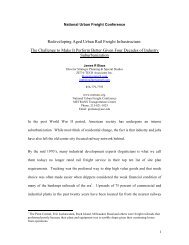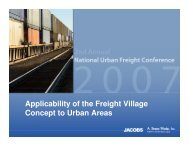Table of Tables - METRANS Transportation Center
Table of Tables - METRANS Transportation Center
Table of Tables - METRANS Transportation Center
Create successful ePaper yourself
Turn your PDF publications into a flip-book with our unique Google optimized e-Paper software.
Evaluating the Feasibility <strong>of</strong> Electrified Rail at the<br />
Port <strong>of</strong> LA/LB<br />
A " dual-mode" P32AC-DM locomotive w as d eveloped by<br />
General Electric to run its electric motors on power from the<br />
onboard Diesel engine or from a third rail carrying 750 volts<br />
<strong>of</strong> direct c urrent and s eamlessly tr ansition between th e two<br />
modes while underway. The P32AC-DM is unique n ot only<br />
because o f t hird-rail c apability, b ut also b ecause i t i s<br />
equipped with AC (alternating current) traction motors.<br />
11<br />
The EMD FL9 (New H aven C lass E DER-5) w as a du alpower<br />
electro-Diesel locomotive, cap able o f s elf-powered<br />
Diesel-electric operation and o f o peration a s a n electric<br />
locomotive powered f rom a third r ail. A t otal o f 6 0 u nits<br />
were b uilt b etween O ctober 1956 and N ovember 1960 by<br />
General M otors E lectro-Motive D ivision as a cu stom o rder<br />
for the New York, New Haven and Hartford Railroad Railed<br />
Crane<br />
Figure 8- Examples <strong>of</strong> Hybrid Locomotives for Use on Electrified Rail<br />
While operation in tunnels created the need for hybrid locomotives, the growing demand<br />
for z ero-emission f reight a nd pa ssenger t ransport r equires “ all-electric” f orms <strong>of</strong><br />
propulsion. W hile t hese f orms o f pr opulsion i n ur ban and i ndustrial areas m ay b e<br />
provided by third rail or catenaries, the exposed electric power lines will likely introduce<br />
numerous safety issues.<br />
3.4 Power Distribution<br />
Power distribution to electrified rail systems is similar to electric grid distribution for any<br />
major power customer. Sub-transmission stations connected to main transmission lines,<br />
typically carrying around 230 kV AC, step down the voltage to anywhere from 11 kV to<br />
56 kV AC depending upon the customer. The power from the sub-transmission stations<br />
is then transmitted to substations along the electrified rail route.<br />
The s ubstations s upply sufficient e lectric pow er t o t rains on t he route. If t he ro ute’s<br />
electric tr ansmission system (third-rail or cat ernary) is not capable <strong>of</strong> de livering<br />
significant pow er, t han the s ubstations need t o be s paced c loser together i n or der to<br />
reduce the number <strong>of</strong> trains operating between substations. T his is the particularly true<br />
for t hird-rail (Figure 9) since t he at -ground a rcing condition l imits th e tr ansmission<br />
voltage—hence i ncreasing cur rent and “i s quared R” losses. In a ddition, the thi rd-rail




